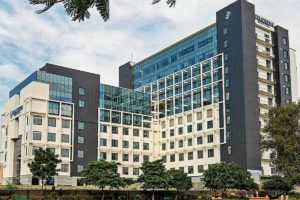Best Sinus Surgery Doctors in India
Best Sinus Surgery Hospitals in India
Lilavati Hospital & Research Centre, Mumbai
- City: Mumbai, India
Hospital Highlights:
- Lilavati Hospital & Research Centre is India’s premier multi-speciality tertiary care hospital and has been recognised as a global medical excellence centre.
- Lilavati Hospital & Research Centre has built an unrivalled level of trust with its patients over the years, thanks to a solid foundation that comprises cutting-edge facilities, the best medical competence, research, education, and charity endeavours.
- The hospital is quite proud of the fact that it now serves patients from all kinds of backgrounds, not just from the United States but from all around the world.
- The hospital has a total of 323 beds, one of the largest Intensive Care Units (ICUs), 12 Operation Theatres with modern amenities, over 300 consultants, and almost 1,800 personnel.
Venkateshwar Hospital, Dwarka, New Delhi
- City: New Delhi, India
Hospital Highlights:
- State-of-the-art technology and devoted healthcare professionals have been brought together under one roof at Venkateshwar Hospital to provide genuine medical care. The hospital’s professionals work together as a team to deliver the best possible treatment to their patients, using the most sophisticated equipment and information technology.
- Venkateshwar Hospital’s mission is to attain global excellence in healthcare by employing evidence-based, ethical clinical practices and cutting-edge technology by a team of highly skilled experts.
Sinus Surgery
Sinuses are cavities inside a person’s skull located around the eyes and nose as well as within the front of the face. Though it is presumed that the sinus system includes the passages behind the nose, there are sinus cavities behind your forehead and eyes as well. People usually have a total of eight sinus cavities.
The procedure which opens the pathways of the sinuses to clear blockages is known as sinus surgery. This is an option for people having ongoing or recurring sinus infections and for people with abnormal sinus structure or abnormal growths in the sinus. Before resorting to this surgery, a doctor generally attempts other treatments and procedures and this surgery is carried out if all other treatments fail to work.
Purpose
The surgery is performed with the goal to remove whatever is blocking the drainage pathways of your sinuses. This can include removing:
- Thin pieces of bone
- Mucous membranes
- Swollen or damaged tissue
- Nasal polyps
- Tumors or growths blocking the nasal or sinus passage
Sinus surgery can also be required for treating a variety of issues and sinusitis and nasal polyps are usually the most common reasons.
- Sinusitis- Swelling of the nasal sinuses or passages is termed as sinusitis. Sometimes it is referred to as a sinus infection. A person with sinusitis can show symptoms of a stuffy nose, cough, pressure around the nose, eyes or forehead, head congestion and headaches, etc.
- Nasal polyps- Nasal polyps are swelling of the nasal lining inside the sinuses and nasal passages. They can vary in size but they are usually teardrop-shaped. Larger polyps or clusters might lead to breathing issues and can affect someone’s sense of smell as well. They may also block a person’s sinuses which can lead to infections.
Even though some may experience no symptoms from nasal polyps, some people can experience any of the common symptoms:
- a blocked nose, leading to difficulty breathing
- recurrent sinus infections
- a runny nose
- a reduced sense of smell or taste
- post-nasal drip
- facial pain
- snoring
- sleep apnea
- headaches
Other reasons- Sometimes sinus surgery can also be required for other infections, abnormal growths, ongoing blockages or any issues that can cause inflammation in the nasal passages and sinuses.
Preparation
Keep in mind that you should avoid over-the-counter drugs such as ibuprofen and aspirin for a week prior to your surgery. However, you need to consult with your doctor as some people shouldn’t be off their medications for too long in some cases.
Start irrigating the sinus passages with a saline spray as well. Also arrange for a ride home after your procedure, as you will not be able to drive.
Procedure
Though endoscopic sinus surgery is the most common type of surgery, there are other types of surgery as well that might be carried out.
Functional endoscopic sinus surgery (FESS)
This surgery is carried out with the help of a tool which is called an endoscope. It is a thin fiber-optic tube. The endoscope will be inserted into the nose to reach the openings of your sinuses.
After this, micro-telescopes and surgical instruments will be passed down the endoscope. They will be used to carry out the procedure. The surgeon will make use of these tools to remove any kind of obstructive tissues as well as other blockages for clearing the sinuses.
The procedure is entirely carried out through the nostrils and leaves little to no scarring. Sometimes a little swelling can occur but it disappears very quickly.
A person having this surgery will usually feel slight discomfort, which will be for a very short time.
FESS can be performed frequently as well as on an outpatient basis.
Image-guided surgery
This surgery is a newer procedure that is usually recommended for severe forms of sinus blockages. It can also be recommended if previous sinus surgeries were not very successful.
Along with an endoscope, this type of surgery makes use of a near-three-dimensional mapping system so that the surgeon can be shown the position of the surgical instruments. This is done using CT scans as well as infrared signals. With the help of this guidance, a surgeon can navigate difficult sinus passages and also remove tissues and other blockages accurately.
Caldwell-Luc operation
This procedure is more invasive as compared to the previous two as well as less common. It is usually carried out to remove growths as well as improve sinus drainage. It creates a pathway between the nose and the cavity beneath the eye which is known as the maxillary sinus. This window will aid in the drainage.
Your surgeon will be making a cut in the upper jaw, above one of your second molar teeth inside your mouth. After this, he/she then enters the sinus cavity through this cut. This surgery can be performed both under local or general anesthetic.
Recovery
After the sinus surgery, nasal packing might be used. Sterile gauze-like material will be inserted into your nasal passage to help control the bleeding. If the packing is absorbable, then it will dissolve over time. However, if it is non-absorbable, your doctor will need to remove it.
The time taken for recovery will depend on the type of surgery that was performed. Age and overall health are also factors. Most people hardly experience any discomfort during this surgery and are able to go home the same day. Also note that it is common to experience mild discomfort, fatigue, nasal congestion as well as small amounts of bleeding.
Remember to follow your doctor’s instructions for aftercare and take medications as prescribed. For the first two weeks after your surgery, you might also need to make a few changes in your daily routine.
The majority of the people who have had sinus surgery have reported that their symptoms have improved a lot after the surgery and they are able to breathe more easily and have fewer infections. They also report an improved sense of smell. Therefore, the surgery seems worth the minimal risks that it carries.



